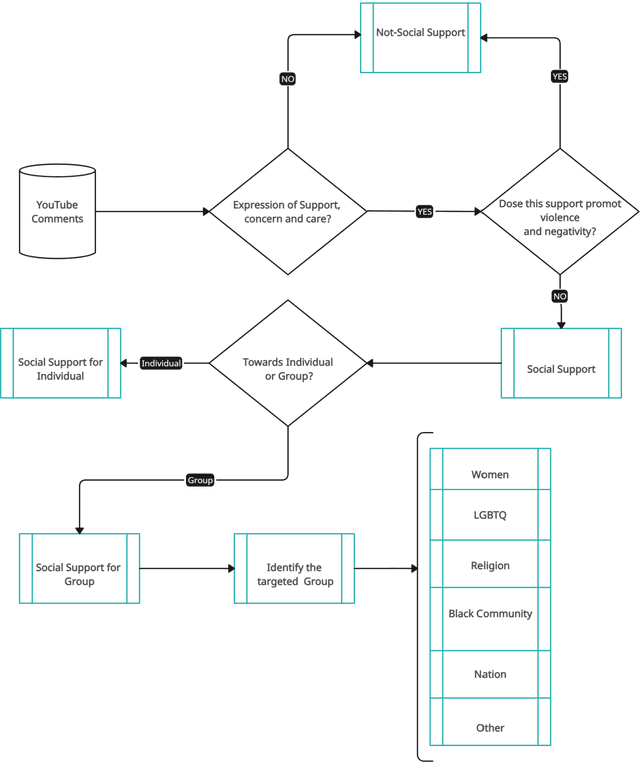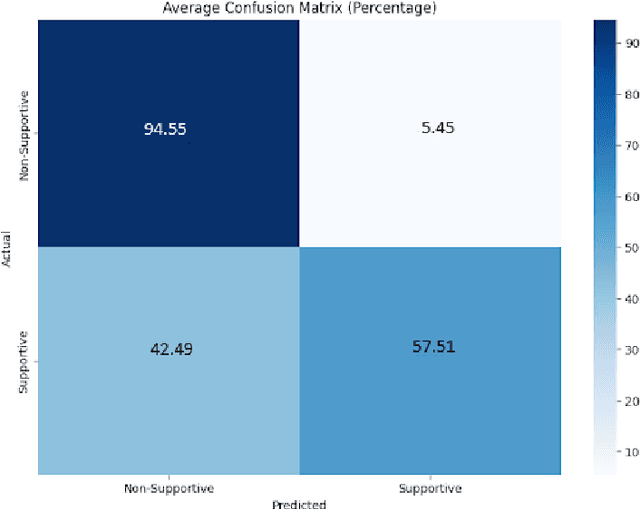Fazlourrahman Balouchzahi
Social Support Detection from Social Media Texts
Nov 04, 2024



Abstract:Social support, conveyed through a multitude of interactions and platforms such as social media, plays a pivotal role in fostering a sense of belonging, aiding resilience in the face of challenges, and enhancing overall well-being. This paper introduces Social Support Detection (SSD) as a Natural language processing (NLP) task aimed at identifying supportive interactions within online communities. The study presents the task of Social Support Detection (SSD) in three subtasks: two binary classification tasks and one multiclass task, with labels detailed in the dataset section. We conducted experiments on a dataset comprising 10,000 YouTube comments. Traditional machine learning models were employed, utilizing various feature combinations that encompass linguistic, psycholinguistic, emotional, and sentiment information. Additionally, we experimented with neural network-based models using various word embeddings to enhance the performance of our models across these subtasks.The results reveal a prevalence of group-oriented support in online dialogues, reflecting broader societal patterns. The findings demonstrate the effectiveness of integrating psycholinguistic, emotional, and sentiment features with n-grams in detecting social support and distinguishing whether it is directed toward an individual or a group. The best results for different subtasks across all experiments range from 0.72 to 0.82.
NLP Progress in Indigenous Latin American Languages
Apr 08, 2024



Abstract:The paper focuses on the marginalization of indigenous language communities in the face of rapid technological advancements. We highlight the cultural richness of these languages and the risk they face of being overlooked in the realm of Natural Language Processing (NLP). We aim to bridge the gap between these communities and researchers, emphasizing the need for inclusive technological advancements that respect indigenous community perspectives. We show the NLP progress of indigenous Latin American languages and the survey that covers the status of indigenous languages in Latin America, their representation in NLP, and the challenges and innovations required for their preservation and development. The paper contributes to the current literature in understanding the need and progress of NLP for indigenous communities of Latin America, specifically low-resource and indigenous communities in general.
GuReT: Distinguishing Guilt and Regret related Text
Jan 29, 2024Abstract:The intricate relationship between human decision-making and emotions, particularly guilt and regret, has significant implications on behavior and well-being. Yet, these emotions subtle distinctions and interplay are often overlooked in computational models. This paper introduces a dataset tailored to dissect the relationship between guilt and regret and their unique textual markers, filling a notable gap in affective computing research. Our approach treats guilt and regret recognition as a binary classification task and employs three machine learning and six transformer-based deep learning techniques to benchmark the newly created dataset. The study further implements innovative reasoning methods like chain-of-thought and tree-of-thought to assess the models interpretive logic. The results indicate a clear performance edge for transformer-based models, achieving a 90.4% macro F1 score compared to the 85.3% scored by the best machine learning classifier, demonstrating their superior capability in distinguishing complex emotional states.
ReDDIT: Regret Detection and Domain Identification from Text
Dec 14, 2022Abstract:In this paper, we present a study of regret and its expression on social media platforms. Specifically, we present a novel dataset of Reddit texts that have been classified into three classes: Regret by Action, Regret by Inaction, and No Regret. We then use this dataset to investigate the language used to express regret on Reddit and to identify the domains of text that are most commonly associated with regret. Our findings show that Reddit users are most likely to express regret for past actions, particularly in the domain of relationships. We also found that deep learning models using GloVe embedding outperformed other models in all experiments, indicating the effectiveness of GloVe for representing the meaning and context of words in the domain of regret. Overall, our study provides valuable insights into the nature and prevalence of regret on social media, as well as the potential of deep learning and word embeddings for analyzing and understanding emotional language in online text. These findings have implications for the development of natural language processing algorithms and the design of social media platforms that support emotional expression and communication.
PolyHope: Two-Level Hope Speech Detection from Tweets
Nov 03, 2022Abstract:Hope is characterized as openness of spirit toward the future, a desire, expectation, and wish for something to happen or to be true that remarkably affects human's state of mind, emotions, behaviors, and decisions. Hope is usually associated with concepts of desired expectations and possibility/probability concerning the future. Despite its importance, hope has rarely been studied as a social media analysis task. This paper presents a hope speech dataset that classifies each tweet first into "Hope" and "Not Hope", then into three fine-grained hope categories: "Generalized Hope", "Realistic Hope", and "Unrealistic Hope" (along with "Not Hope"). English tweets in the first half of 2022 were collected to build this dataset. Furthermore, we describe our annotation process and guidelines in detail and discuss the challenges of classifying hope and the limitations of the existing hope speech detection corpora. In addition, we reported several baselines based on different learning approaches, such as traditional machine learning, deep learning, and transformers, to benchmark our dataset. We evaluated our baselines using weighted-averaged and macro-averaged F1-scores. Observations show that a strict process for annotator selection and detailed annotation guidelines enhanced the dataset's quality. This strict annotation process resulted in promising performance for simple machine learning classifiers with only bi-grams; however, binary and multiclass hope speech detection results reveal that contextual embedding models have higher performance in this dataset.
 Add to Chrome
Add to Chrome Add to Firefox
Add to Firefox Add to Edge
Add to Edge